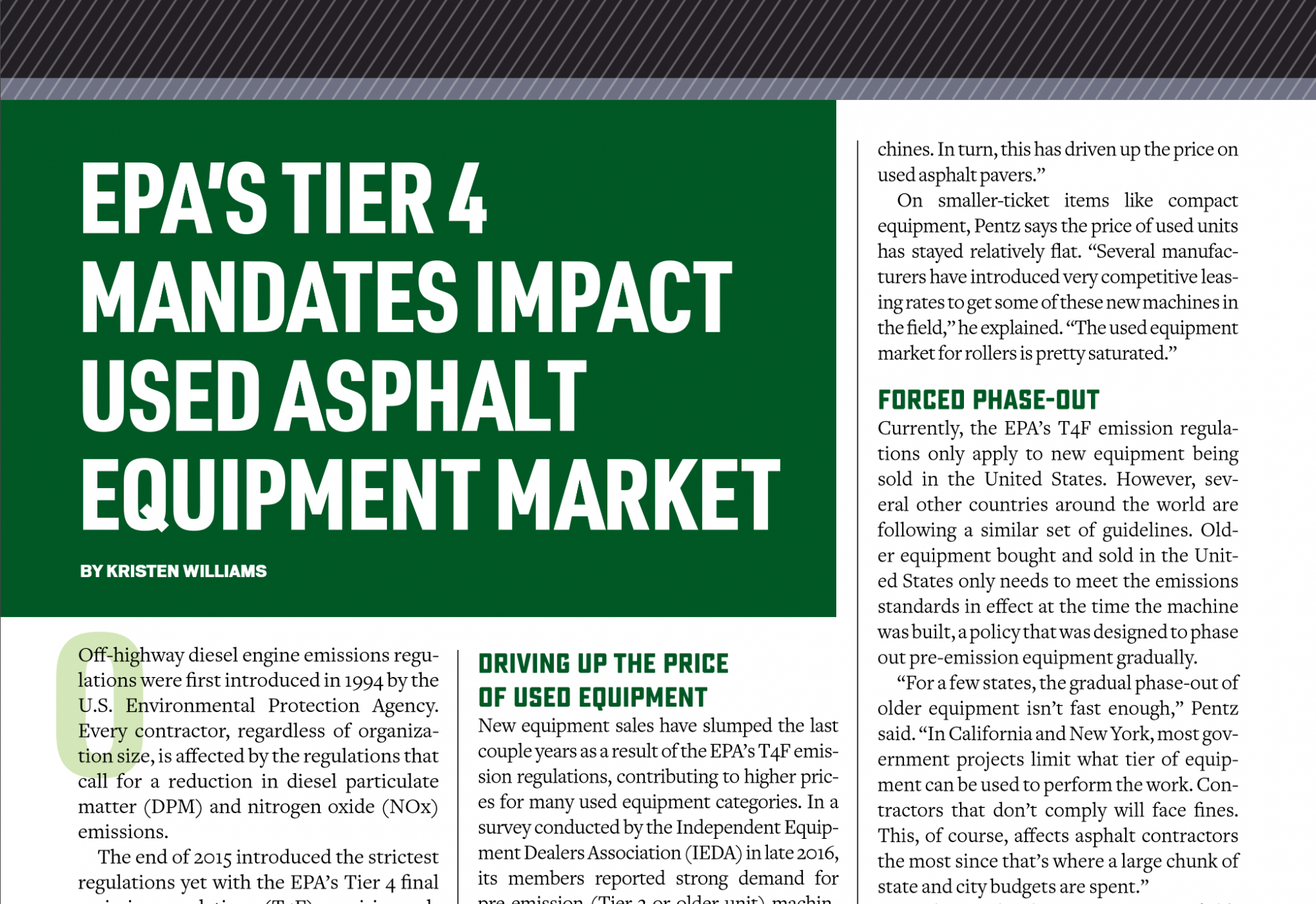EPA’s Tier 4 Mandates Impact Used Asphalt Equipment Market
BY Kristen Williams

Off-highway diesel engine emissions regulations were first introduced in 1994 by the U.S. Environmental Protection Agency. Every contractor, regardless of organization size, is affected by the regulations that call for a reduction in diesel particulate matter (DPM) and nitrogen oxide (NOx) emissions.
The end of 2015 introduced the strictest regulations yet with the EPA’s Tier 4 final emission regulations (T4F) requiring pollutants to be reduced by as much as 90 percent from previous models. This feat could only be accomplished by reinventing the diesel engine and exhaust system found in 50-horsepower and above off-highway equipment.
In response, manufacturers switched from mechanical engines to electronically controlled engines that use an engine control module. This change enabled regulation of an after treatment system, which is responsible for controlling soot and NOx gas released into the environment.
While the T4F engines are a modern marvel, these advancements come with a significant cost increase for every contractor. These engines are more expensive to produce, sometimes driving the purchase price up as much as 20 percent for machines with this new technology. This sticker shock combined with maintenance concerns has driven contractors into holding onto older machines longer and buying more used equipment than they have in the past.
Driving up the price of used equipment
New equipment sales have slumped the last couple years as a result of the EPA’s T4F emission regulations, contributing to higher prices for many used equipment categories. In a survey conducted by the Independent Equipment Dealers Association (IEDA) in late 2016, its members reported strong demand for pre-emission (Tier 3 or older unit) machinery. And, they predicted the trend would continue for several years. This demand is driving prices higher on quality, low-hour equipment—something IEDA members say is getting much harder to find in North America.
The survey also found that some categories are seeing prices on used machines increase by as much as 20 percent when compared to pricing a few years ago. The equipment categories with the highest demands include excavators, backhoe loaders, wheel loaders, dump trucks, dozers and compact equipment.
“Unlike a lot of construction equipment, large asphalt pavers aren’t a commodity item so often paving contractors hang onto their machines longer than in other construction segments,” said Mark Pentz, IEDA member and owner of Calvin Group Inc. in Windsor, Colorado, which specializes in buying and selling used asphalt equipment. “With the extra expense to buy new equipment and concerns about the ability to perform maintenance and repairs on their own, paving contractors are choosing to fix what they have instead of trading them in or selling the machines. In turn, this has driven up the price on used asphalt pavers.”
On smaller-ticket items like compact equipment, Pentz says the price of used units has stayed relatively flat. “Several manufacturers have introduced very competitive leasing rates to get some of these new machines in the field,” he explained. “The used equipment market for rollers is pretty saturated.”
Forced phase-out
Currently, the EPA’s T4F emission regulations only apply to new equipment being sold in the United States. However, several other countries around the world are following a similar set of guidelines. Older equipment bought and sold in the United States only needs to meet the emissions standards in effect at the time the machine was built, a policy that was designed to phase out pre-emission equipment gradually.
“For a few states, the gradual phase-out of older equipment isn’t fast enough,” Pentz said. “In California and New York, most government projects limit what tier of equipment can be used to perform the work. Contractors that don’t comply will face fines. This, of course, affects asphalt contractors the most since that’s where a large chunk of state and city budgets are spent.”
Furthering the phasing out process of older equipment, some states have also adopted their own regulations to reduce PM and NOx emissions. In 2007, California set up the California Air Resource Board (CARB) to implement its own policy. The next major milestone of its regulations hits in January 2018, when diesel equipment fleets classified as large and medium will be prohibited from adding any Tier 2 engine vehicles—a policy that will affect the used equipment market for the state.
“Asphalt contractors that operate in California, New York and downtown Chicago are among the most impacted by state and city policies,” Pentz said. “We’ve been working with those contractors to ensure they get the best value for their pre-emissions asphalt pavers and then reselling them to contractors in other states, primarily Midwestern, that do not have strict regulations in place yet. There’s a lot of life left in these machines, but the previous owners don’t have a choice about hanging on to them.”
Looking ahead
According to the IEDA members surveyed, there is uncertainty about how Tier 4 equipment will maintain its residual value when it comes time to trade it in or sell it. “It’s going to depend a lot on the type of machine, the engine make and model, as well as the type of after treatment system used on it,” Pentz said. “There just isn’t enough time in the field yet to know how these new machines will hold up over time.”
Beyond the used equipment market in North America, many machines will make their way to developing countries. However, the low ash oil and ultra-low sulfur diesel required by Tier 4 equipment aren’t widely available in those countries yet. So, any Tier 4 machine sold to a contractor in a developing country will have to be converted. Pentz said that conversion process can be costly. “Given those additional costs, it’s difficult to imagine these machines having as long of a life as what we’ve seen in the past,” he added.
The future of used Tier 4 equipment is uncertain, but eventually, there will not be any quality pre-emission used equipment available. At that time, the used market will settle down, and manufacturers will have hopefully been able to come up with solutions to contractors’ concerns.
When to sell used equipment
“For contractors who are considering selling their pre-emission equipment and updating to Tier 4 machines, there isn’t really an ideal time to do it,” Pentz said. “Right now, quality used asphalt equipment is selling for more, but contractors will also pay more buying new. However, if they wait too long to sell older machines, there may not be as much of a demand for it, because of state and city regulations.”
Pentz adds that IEDA members have a good pulse on the used equipment market, and any one of them can help a contractor evaluate his or her options.

Kristin Williams
Kristen Williams is the executive director for the Independent Equipment Dealers Association (IEDA). With a curiosity for learning and a passion for building relationships, she has led the IEDA to new heights and has seen a tenfold growth in membership since being hired in 2009. With a professional background in trade publishing and conference planning, Kristen has extensive knowledge and experience in the used equipment market. Established in 2002, IEDA is a self-regulating body of independent dealers who pride themselves on being reputable, highly qualified professionals in the used equipment market worldwide. Standard members buy and sell equipment on a wholesale and retail level via the IEDA. Associate members offer products and services to the core group. All members must apply for membership and be approved by the Board of Directors. For more information, please visit iedagroup.com.
